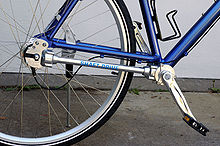
Back Bicicleta con transmisión por eje Spanish シャフトドライブ Japanese Кардански велосипед Macedonian Fiets met asaandrijving Dutch Akseldrevet sykkel NB Велосипед с вальным приводом Russian Велосипед з вальним приводом Ukrainian 軸傳動 Chinese


A shaft-driven bicycle is a bicycle that uses a drive shaft instead of a chain to transmit power from the pedals to the wheel. Shaft drives were introduced in the 1880s, but were mostly supplanted by chain-driven bicycles due to the gear ranges possible with sprockets and derailleurs. Around the 2000s, due to advancements in internal gear technology, a small number of modern shaft-driven bicycles have been introduced.
Shaft-driven bikes have a large bevel gear where a conventional bike would have its chain ring. This meshes with another bevel gear mounted on the drive shaft. The use of bevel gears allows the axis of the drive torque from the pedals to be turned through 90 degrees. The drive shaft then has another bevel gear near the rear wheel hub which meshes with a bevel gear on the hub where the rear sprocket would be on a conventional bike, and canceling out the first drive torque change of axis.
The 90-degree change of the drive plane that occurs at the bottom bracket and again at the rear hub uses bevel gears for the most efficient performance, though other mechanisms could be used, e.g. hobson's joints, worm gears or crossed helical gears.
The drive shaft is often mated to a hub gear which is an internal gear system housed inside the rear hub. Manufacturers of internal hubs suitable for use with shaft drive systems include NuVinci, Rohloff, Shimano, SRAM, and Sturmey-Archer.
© MMXXIII Rich X Search. We shall prevail. All rights reserved. Rich X Search